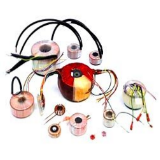 |
Decknetics (S) Pte Ltd offers customized toroidal transformers in accordance to customers’ simplest to the most elaborate design requirements.
With your detailed parameters, Decknetics’ highly experienced R&D team equipped with cutting-edge software programs will excogitate the most optimum,
efficient and high technology transformer even with your most complex design.
In general, toroidal transformers exhibit many advantages over standard laminated transformers.Toroidal Transformers provide quiet, efficient operation with
extremely low stray magnetic fields. The dynamic donut shaped core allows all of the core molecules to be aligned with the direction of magnetic flux.Molecules
not aligned with the flux direction increases core’s reluctance which will in turn decrease the performance when the molecules are out of phase which is evident
in EI laminated cores.EI laminated cores, which are stamped from grain-oriented Si-Fe, may have as much as 40% of the total core area perpendicular to the ideal
grain direction, with another 40% acting only as a return flux path.This more efficient use of the material in a toroidal core can result in a significant size and
weight reduction, thus allowing the design engineers to innovate complicated designs from the toroidal core's small size, low weight, ease of mounting, and flexible
dimensions.
|
|
Since toroidal cores are constructed of a continuously wound ribbon, there is virtually no air gap.The windings are evenly wrapped over the entire core allowing the
transformer to operate at a higher flux density than in standard transformers.Toroidal transformers can operate at 1.6 to 1.8 Tesla (16,000 to 18,000 Gauss) while
EI cores are limited to 1.2 to 1.4 Tesla (12,000 to 14,000 Gauss).The magnetic flux of the windings is oriented in the same direction as the grain-oriented core,
thus achieving very high electrical efficiencies.
The primary cause of flux leakage from any transformer is due to the air gap. In traditional transformers with EI laminations stacked to form the core, the air gap
at the junction of the I and the E is the source of most flux leakage. This flux strays into the surroundings due to the high reluctance of the air and the
concentration of flux in the laminations. Mounting holes and grooves in the laminations also cause a small amount of leakage flux. The composition and construction
of the toroidal core eliminates stray magnetic fields from air gaps which reduces flux leakage to a minimum. In addition, the windings of the toroidal transformer
uniformly encase the core in copper. This results in a natural magnetic screening effect which, in combination with the elimination of the air gap, results in an 8:1
reduction of radiated magnetic field over an equivalent rated EI transformer. Audible noise can be reduced even further by varnish impregnating the toroidal core or
the copper windings.
Size consideration is also an advantage when using toroidal transformers. While the cross-sectional area of the toroidal core must be held constant, the height and
diameter may be varied to meet parameter constraints. The only physical restrictions on the size of a toroidal transformer are the limitations of the winding
machinery. A minimum inner diameter must be maintained in order to permit the insertion of the magazine shuttle during the winding process.
|
